A Performance Management Full Cycle from Induction
VerifiedAdded on 2019/09/21
|7
|1382
|318
Report
AI Summary
The provided assignment content focuses on the process of Performance Management (PM) in an organization, highlighting its various components and importance in promoting challenge, building capability, recognizing and rewarding talent. The PM process involves appraisal, goal setting, PDP planning, line manager roles, HR administration, learning and development, diversity and inclusion, talent management, succession planning, reward, employee engagement, change management, communities of practice, EVP (Employee Value Proposition), brand strategy, culture, and communication. The content emphasizes the significance of PM in driving organizational performance and highlights its role in building a positive work environment.
Contribute Materials
Your contribution can guide someone’s learning journey. Share your
documents today.
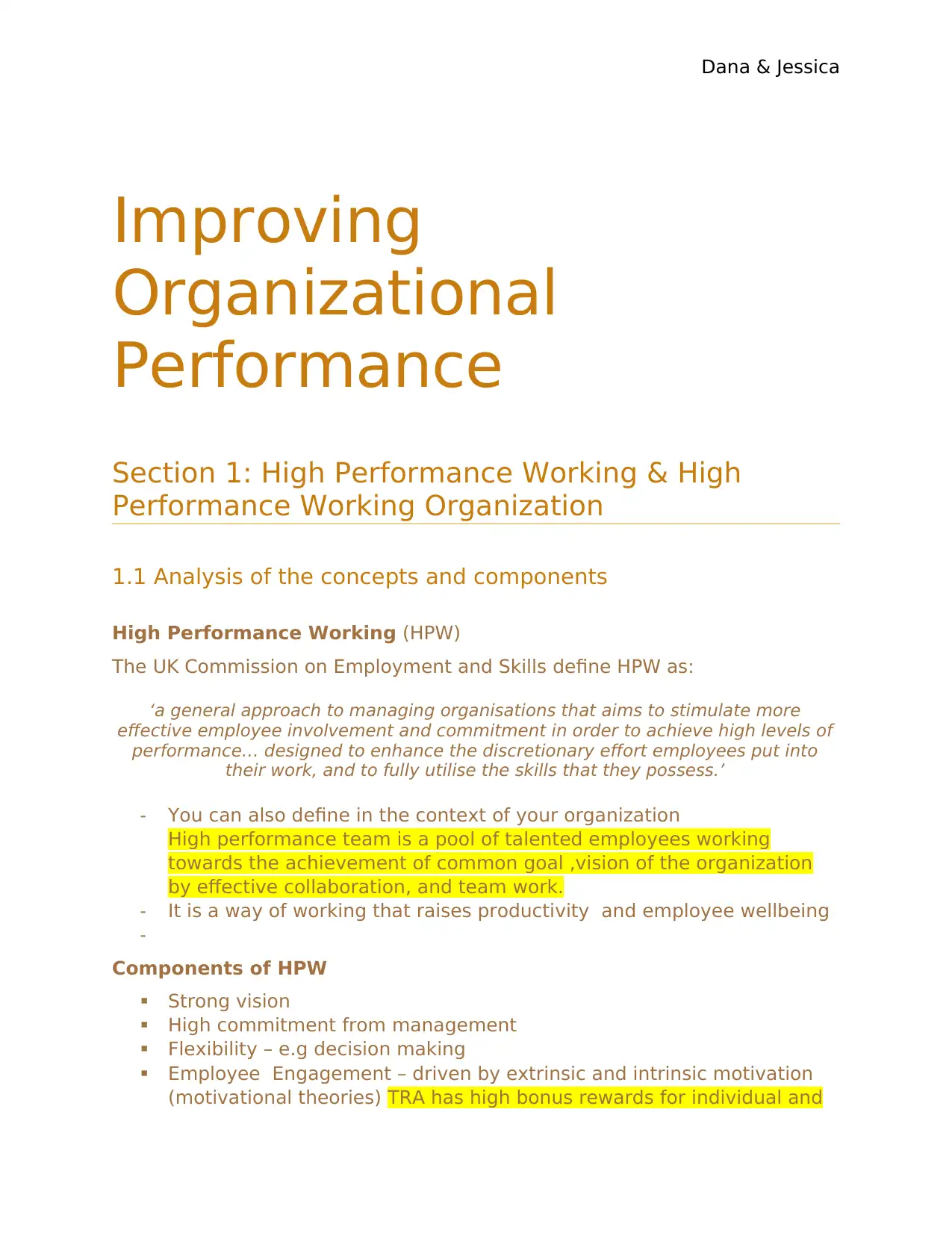
Dana & Jessica
Improving
Organizational
Performance
Section 1: High Performance Working & High
Performance Working Organization
1.1 Analysis of the concepts and components
High Performance Working (HPW)
The UK Commission on Employment and Skills define HPW as:
‘a general approach to managing organisations that aims to stimulate more
effective employee involvement and commitment in order to achieve high levels of
performance… designed to enhance the discretionary effort employees put into
their work, and to fully utilise the skills that they possess.’
- You can also define in the context of your organization
High performance team is a pool of talented employees working
towards the achievement of common goal ,vision of the organization
by effective collaboration, and team work.
- It is a way of working that raises productivity and employee wellbeing
-
Components of HPW
Strong vision
High commitment from management
Flexibility – e.g decision making
Employee Engagement – driven by extrinsic and intrinsic motivation
(motivational theories) TRA has high bonus rewards for individual and
Improving
Organizational
Performance
Section 1: High Performance Working & High
Performance Working Organization
1.1 Analysis of the concepts and components
High Performance Working (HPW)
The UK Commission on Employment and Skills define HPW as:
‘a general approach to managing organisations that aims to stimulate more
effective employee involvement and commitment in order to achieve high levels of
performance… designed to enhance the discretionary effort employees put into
their work, and to fully utilise the skills that they possess.’
- You can also define in the context of your organization
High performance team is a pool of talented employees working
towards the achievement of common goal ,vision of the organization
by effective collaboration, and team work.
- It is a way of working that raises productivity and employee wellbeing
-
Components of HPW
Strong vision
High commitment from management
Flexibility – e.g decision making
Employee Engagement – driven by extrinsic and intrinsic motivation
(motivational theories) TRA has high bonus rewards for individual and
Secure Best Marks with AI Grader
Need help grading? Try our AI Grader for instant feedback on your assignments.
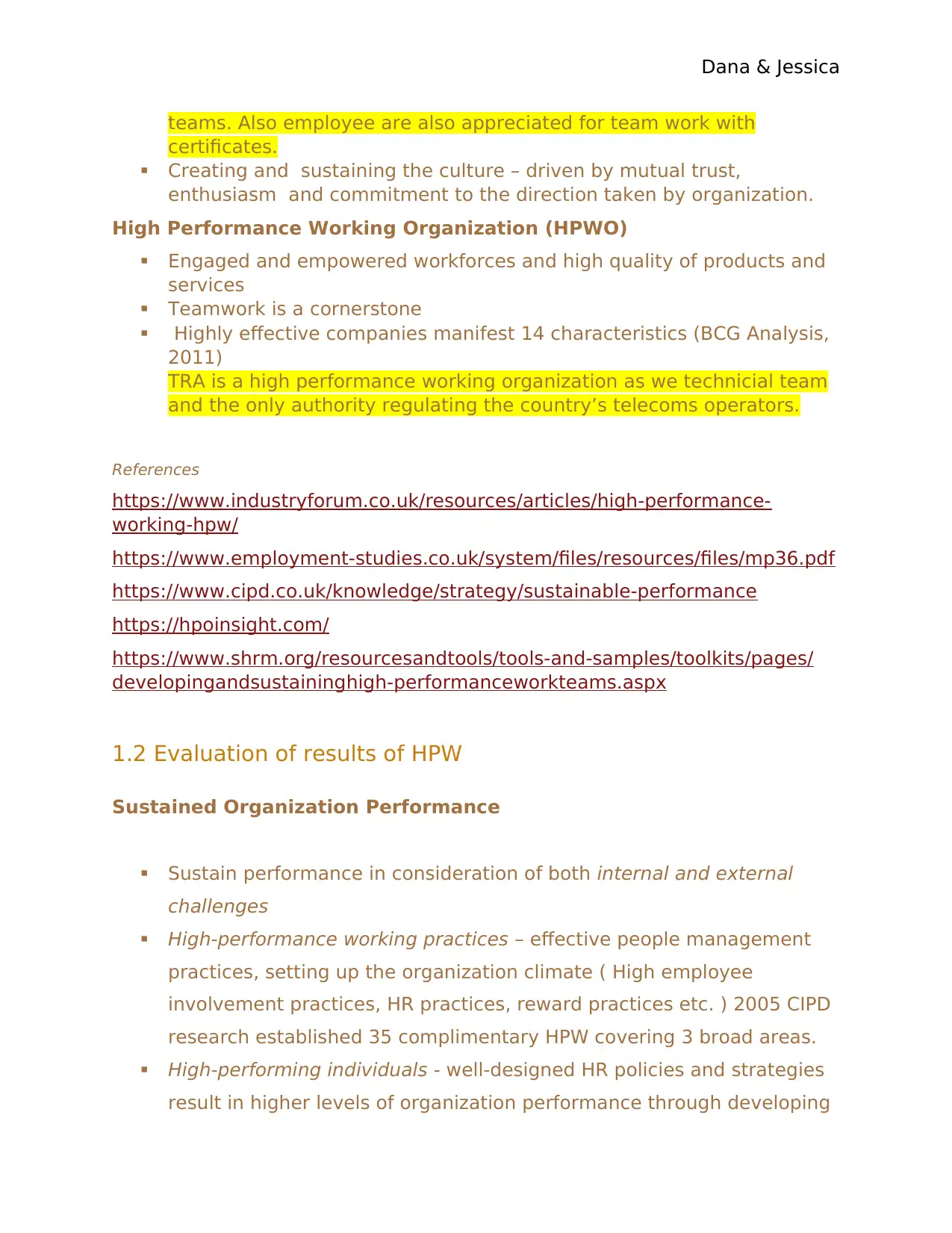
Dana & Jessica
teams. Also employee are also appreciated for team work with
certificates.
Creating and sustaining the culture – driven by mutual trust,
enthusiasm and commitment to the direction taken by organization.
High Performance Working Organization (HPWO)
Engaged and empowered workforces and high quality of products and
services
Teamwork is a cornerstone
Highly effective companies manifest 14 characteristics (BCG Analysis,
2011)
TRA is a high performance working organization as we technicial team
and the only authority regulating the country’s telecoms operators.
References
https://www.industryforum.co.uk/resources/articles/high-performance-
working-hpw/
https://www.employment-studies.co.uk/system/files/resources/files/mp36.pdf
https://www.cipd.co.uk/knowledge/strategy/sustainable-performance
https://hpoinsight.com/
https://www.shrm.org/resourcesandtools/tools-and-samples/toolkits/pages/
developingandsustaininghigh-performanceworkteams.aspx
1.2 Evaluation of results of HPW
Sustained Organization Performance
Sustain performance in consideration of both internal and external
challenges
High-performance working practices – effective people management
practices, setting up the organization climate ( High employee
involvement practices, HR practices, reward practices etc. ) 2005 CIPD
research established 35 complimentary HPW covering 3 broad areas.
High-performing individuals - well-designed HR policies and strategies
result in higher levels of organization performance through developing
teams. Also employee are also appreciated for team work with
certificates.
Creating and sustaining the culture – driven by mutual trust,
enthusiasm and commitment to the direction taken by organization.
High Performance Working Organization (HPWO)
Engaged and empowered workforces and high quality of products and
services
Teamwork is a cornerstone
Highly effective companies manifest 14 characteristics (BCG Analysis,
2011)
TRA is a high performance working organization as we technicial team
and the only authority regulating the country’s telecoms operators.
References
https://www.industryforum.co.uk/resources/articles/high-performance-
working-hpw/
https://www.employment-studies.co.uk/system/files/resources/files/mp36.pdf
https://www.cipd.co.uk/knowledge/strategy/sustainable-performance
https://hpoinsight.com/
https://www.shrm.org/resourcesandtools/tools-and-samples/toolkits/pages/
developingandsustaininghigh-performanceworkteams.aspx
1.2 Evaluation of results of HPW
Sustained Organization Performance
Sustain performance in consideration of both internal and external
challenges
High-performance working practices – effective people management
practices, setting up the organization climate ( High employee
involvement practices, HR practices, reward practices etc. ) 2005 CIPD
research established 35 complimentary HPW covering 3 broad areas.
High-performing individuals - well-designed HR policies and strategies
result in higher levels of organization performance through developing
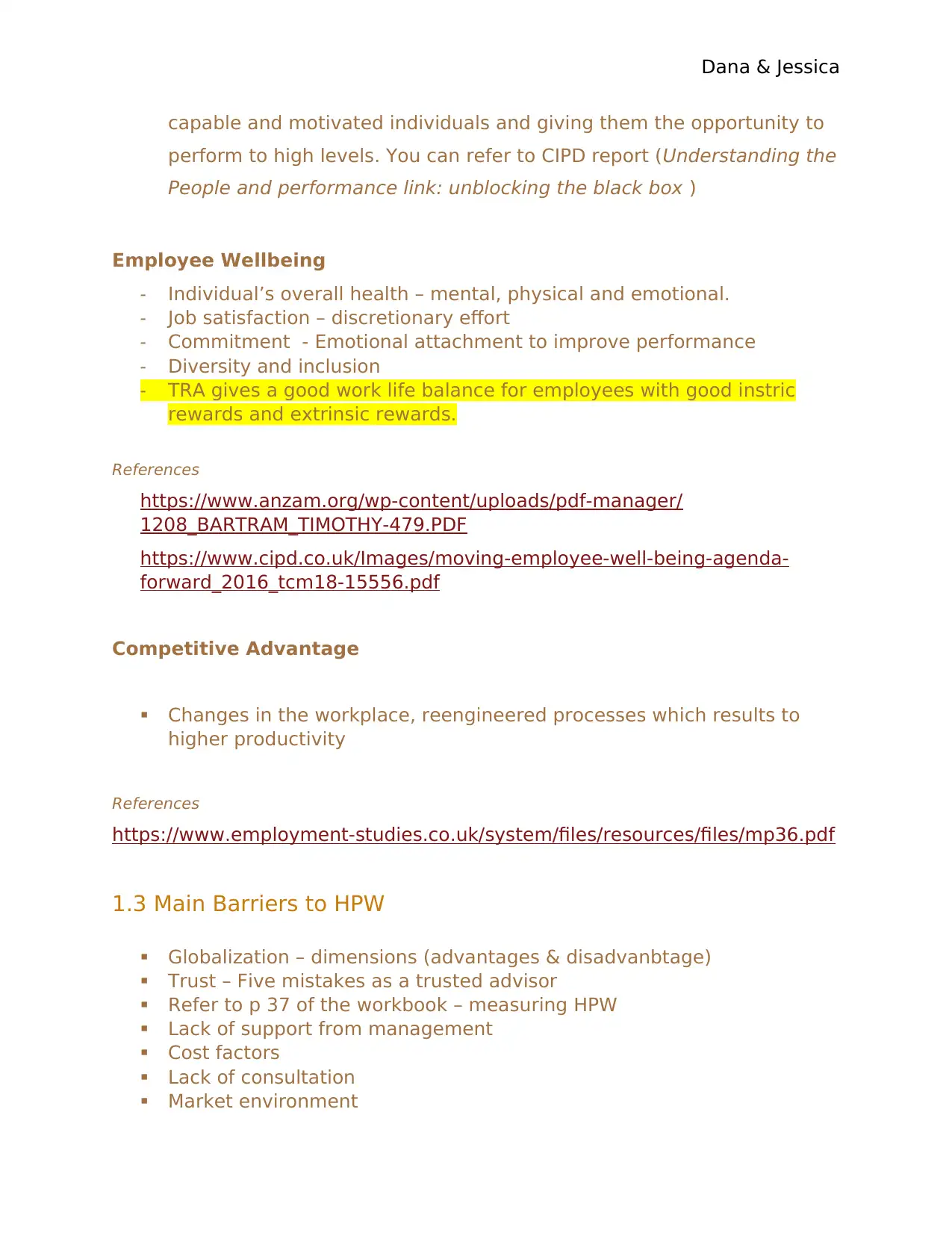
Dana & Jessica
capable and motivated individuals and giving them the opportunity to
perform to high levels. You can refer to CIPD report (Understanding the
People and performance link: unblocking the black box )
Employee Wellbeing
- Individual’s overall health – mental, physical and emotional.
- Job satisfaction – discretionary effort
- Commitment - Emotional attachment to improve performance
- Diversity and inclusion
- TRA gives a good work life balance for employees with good instric
rewards and extrinsic rewards.
References
https://www.anzam.org/wp-content/uploads/pdf-manager/
1208_BARTRAM_TIMOTHY-479.PDF
https://www.cipd.co.uk/Images/moving-employee-well-being-agenda-
forward_2016_tcm18-15556.pdf
Competitive Advantage
Changes in the workplace, reengineered processes which results to
higher productivity
References
https://www.employment-studies.co.uk/system/files/resources/files/mp36.pdf
1.3 Main Barriers to HPW
Globalization – dimensions (advantages & disadvanbtage)
Trust – Five mistakes as a trusted advisor
Refer to p 37 of the workbook – measuring HPW
Lack of support from management
Cost factors
Lack of consultation
Market environment
capable and motivated individuals and giving them the opportunity to
perform to high levels. You can refer to CIPD report (Understanding the
People and performance link: unblocking the black box )
Employee Wellbeing
- Individual’s overall health – mental, physical and emotional.
- Job satisfaction – discretionary effort
- Commitment - Emotional attachment to improve performance
- Diversity and inclusion
- TRA gives a good work life balance for employees with good instric
rewards and extrinsic rewards.
References
https://www.anzam.org/wp-content/uploads/pdf-manager/
1208_BARTRAM_TIMOTHY-479.PDF
https://www.cipd.co.uk/Images/moving-employee-well-being-agenda-
forward_2016_tcm18-15556.pdf
Competitive Advantage
Changes in the workplace, reengineered processes which results to
higher productivity
References
https://www.employment-studies.co.uk/system/files/resources/files/mp36.pdf
1.3 Main Barriers to HPW
Globalization – dimensions (advantages & disadvanbtage)
Trust – Five mistakes as a trusted advisor
Refer to p 37 of the workbook – measuring HPW
Lack of support from management
Cost factors
Lack of consultation
Market environment
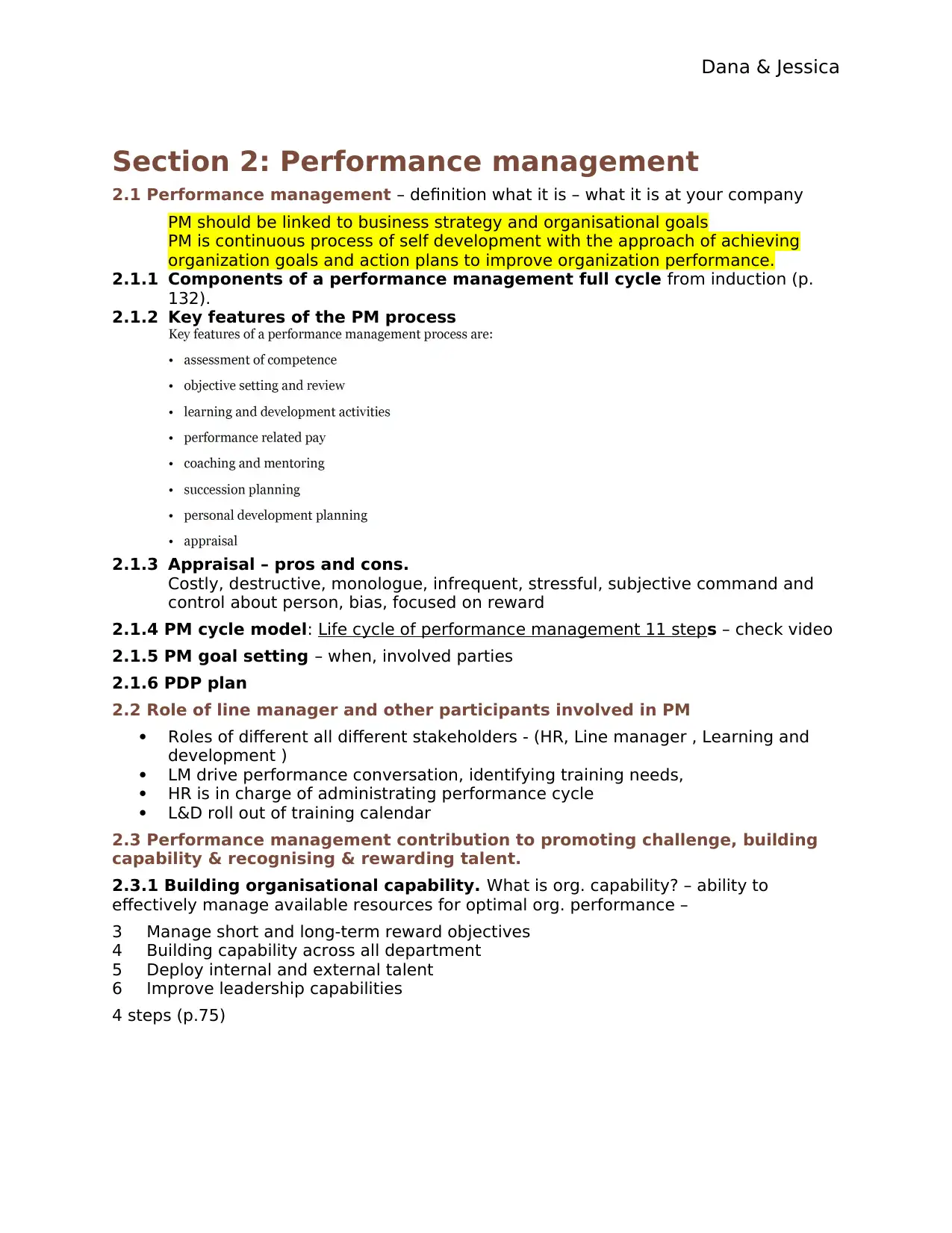
Dana & Jessica
Section 2: Performance management
2.1 Performance management – definition what it is – what it is at your company
PM should be linked to business strategy and organisational goals
PM is continuous process of self development with the approach of achieving
organization goals and action plans to improve organization performance.
2.1.1 Components of a performance management full cycle from induction (p.
132).
2.1.2 Key features of the PM process
2.1.3 Appraisal – pros and cons.
Costly, destructive, monologue, infrequent, stressful, subjective command and
control about person, bias, focused on reward
2.1.4 PM cycle model: Life cycle of performance management 11 steps – check video
2.1.5 PM goal setting – when, involved parties
2.1.6 PDP plan
2.2 Role of line manager and other participants involved in PM
Roles of different all different stakeholders - (HR, Line manager , Learning and
development )
LM drive performance conversation, identifying training needs,
HR is in charge of administrating performance cycle
L&D roll out of training calendar
2.3 Performance management contribution to promoting challenge, building
capability & recognising & rewarding talent.
2.3.1 Building organisational capability. What is org. capability? – ability to
effectively manage available resources for optimal org. performance –
3 Manage short and long-term reward objectives
4 Building capability across all department
5 Deploy internal and external talent
6 Improve leadership capabilities
4 steps (p.75)
Section 2: Performance management
2.1 Performance management – definition what it is – what it is at your company
PM should be linked to business strategy and organisational goals
PM is continuous process of self development with the approach of achieving
organization goals and action plans to improve organization performance.
2.1.1 Components of a performance management full cycle from induction (p.
132).
2.1.2 Key features of the PM process
2.1.3 Appraisal – pros and cons.
Costly, destructive, monologue, infrequent, stressful, subjective command and
control about person, bias, focused on reward
2.1.4 PM cycle model: Life cycle of performance management 11 steps – check video
2.1.5 PM goal setting – when, involved parties
2.1.6 PDP plan
2.2 Role of line manager and other participants involved in PM
Roles of different all different stakeholders - (HR, Line manager , Learning and
development )
LM drive performance conversation, identifying training needs,
HR is in charge of administrating performance cycle
L&D roll out of training calendar
2.3 Performance management contribution to promoting challenge, building
capability & recognising & rewarding talent.
2.3.1 Building organisational capability. What is org. capability? – ability to
effectively manage available resources for optimal org. performance –
3 Manage short and long-term reward objectives
4 Building capability across all department
5 Deploy internal and external talent
6 Improve leadership capabilities
4 steps (p.75)
Secure Best Marks with AI Grader
Need help grading? Try our AI Grader for instant feedback on your assignments.
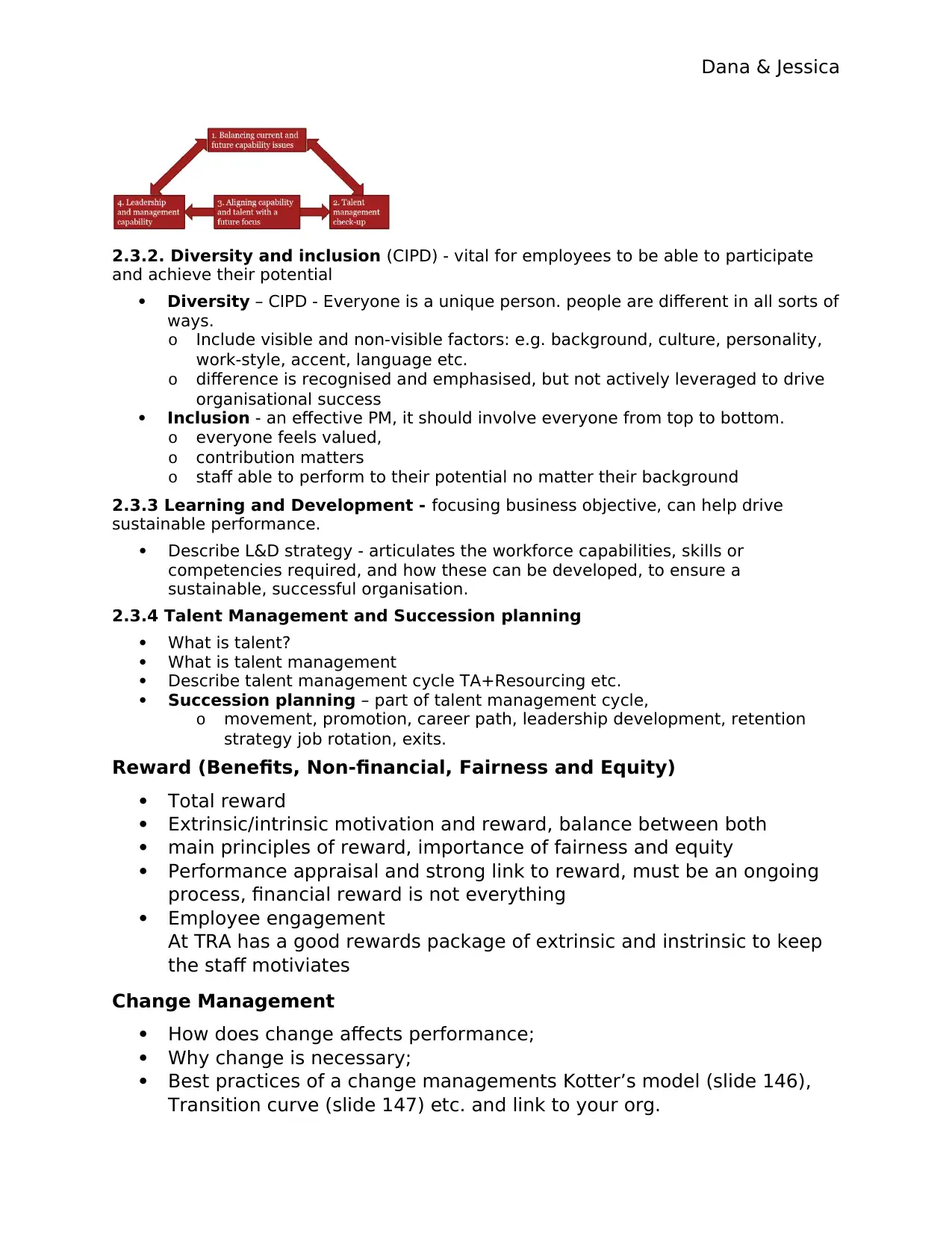
Dana & Jessica
2.3.2. Diversity and inclusion (CIPD) - vital for employees to be able to participate
and achieve their potential
Diversity – CIPD - Everyone is a unique person. people are different in all sorts of
ways.
o Include visible and non-visible factors: e.g. background, culture, personality,
work-style, accent, language etc.
o difference is recognised and emphasised, but not actively leveraged to drive
organisational success
Inclusion - an effective PM, it should involve everyone from top to bottom.
o everyone feels valued,
o contribution matters
o staff able to perform to their potential no matter their background
2.3.3 Learning and Development - focusing business objective, can help drive
sustainable performance.
Describe L&D strategy - articulates the workforce capabilities, skills or
competencies required, and how these can be developed, to ensure a
sustainable, successful organisation.
2.3.4 Talent Management and Succession planning
What is talent?
What is talent management
Describe talent management cycle TA+Resourcing etc.
Succession planning – part of talent management cycle,
o movement, promotion, career path, leadership development, retention
strategy job rotation, exits.
Reward (Benefits, Non-financial, Fairness and Equity)
Total reward
Extrinsic/intrinsic motivation and reward, balance between both
main principles of reward, importance of fairness and equity
Performance appraisal and strong link to reward, must be an ongoing
process, financial reward is not everything
Employee engagement
At TRA has a good rewards package of extrinsic and instrinsic to keep
the staff motiviates
Change Management
How does change affects performance;
Why change is necessary;
Best practices of a change managements Kotter’s model (slide 146),
Transition curve (slide 147) etc. and link to your org.
2.3.2. Diversity and inclusion (CIPD) - vital for employees to be able to participate
and achieve their potential
Diversity – CIPD - Everyone is a unique person. people are different in all sorts of
ways.
o Include visible and non-visible factors: e.g. background, culture, personality,
work-style, accent, language etc.
o difference is recognised and emphasised, but not actively leveraged to drive
organisational success
Inclusion - an effective PM, it should involve everyone from top to bottom.
o everyone feels valued,
o contribution matters
o staff able to perform to their potential no matter their background
2.3.3 Learning and Development - focusing business objective, can help drive
sustainable performance.
Describe L&D strategy - articulates the workforce capabilities, skills or
competencies required, and how these can be developed, to ensure a
sustainable, successful organisation.
2.3.4 Talent Management and Succession planning
What is talent?
What is talent management
Describe talent management cycle TA+Resourcing etc.
Succession planning – part of talent management cycle,
o movement, promotion, career path, leadership development, retention
strategy job rotation, exits.
Reward (Benefits, Non-financial, Fairness and Equity)
Total reward
Extrinsic/intrinsic motivation and reward, balance between both
main principles of reward, importance of fairness and equity
Performance appraisal and strong link to reward, must be an ongoing
process, financial reward is not everything
Employee engagement
At TRA has a good rewards package of extrinsic and instrinsic to keep
the staff motiviates
Change Management
How does change affects performance;
Why change is necessary;
Best practices of a change managements Kotter’s model (slide 146),
Transition curve (slide 147) etc. and link to your org.
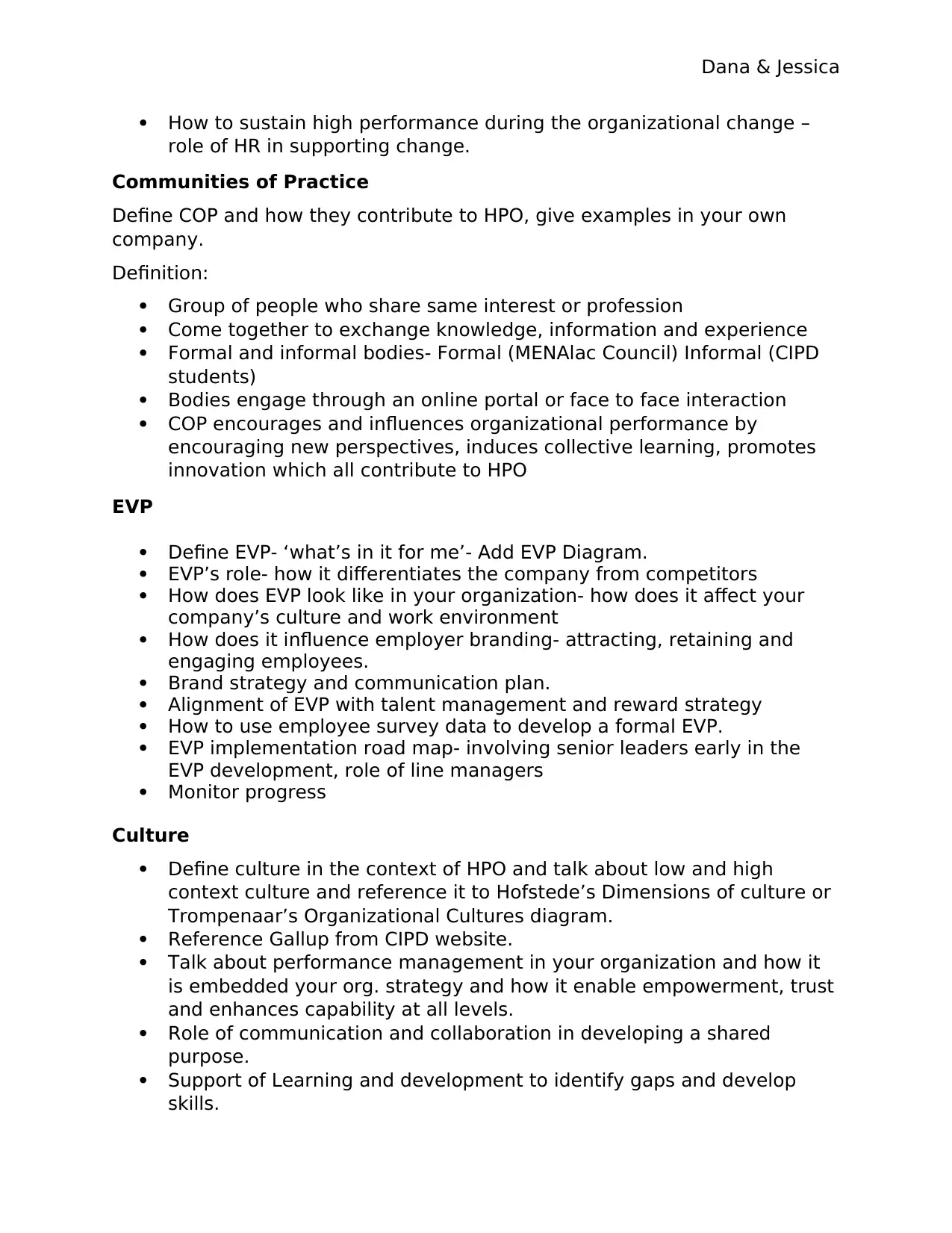
Dana & Jessica
How to sustain high performance during the organizational change –
role of HR in supporting change.
Communities of Practice
Define COP and how they contribute to HPO, give examples in your own
company.
Definition:
Group of people who share same interest or profession
Come together to exchange knowledge, information and experience
Formal and informal bodies- Formal (MENAlac Council) Informal (CIPD
students)
Bodies engage through an online portal or face to face interaction
COP encourages and influences organizational performance by
encouraging new perspectives, induces collective learning, promotes
innovation which all contribute to HPO
EVP
Define EVP- ‘what’s in it for me’- Add EVP Diagram.
EVP’s role- how it differentiates the company from competitors
How does EVP look like in your organization- how does it affect your
company’s culture and work environment
How does it influence employer branding- attracting, retaining and
engaging employees.
Brand strategy and communication plan.
Alignment of EVP with talent management and reward strategy
How to use employee survey data to develop a formal EVP.
EVP implementation road map- involving senior leaders early in the
EVP development, role of line managers
Monitor progress
Culture
Define culture in the context of HPO and talk about low and high
context culture and reference it to Hofstede’s Dimensions of culture or
Trompenaar’s Organizational Cultures diagram.
Reference Gallup from CIPD website.
Talk about performance management in your organization and how it
is embedded your org. strategy and how it enable empowerment, trust
and enhances capability at all levels.
Role of communication and collaboration in developing a shared
purpose.
Support of Learning and development to identify gaps and develop
skills.
How to sustain high performance during the organizational change –
role of HR in supporting change.
Communities of Practice
Define COP and how they contribute to HPO, give examples in your own
company.
Definition:
Group of people who share same interest or profession
Come together to exchange knowledge, information and experience
Formal and informal bodies- Formal (MENAlac Council) Informal (CIPD
students)
Bodies engage through an online portal or face to face interaction
COP encourages and influences organizational performance by
encouraging new perspectives, induces collective learning, promotes
innovation which all contribute to HPO
EVP
Define EVP- ‘what’s in it for me’- Add EVP Diagram.
EVP’s role- how it differentiates the company from competitors
How does EVP look like in your organization- how does it affect your
company’s culture and work environment
How does it influence employer branding- attracting, retaining and
engaging employees.
Brand strategy and communication plan.
Alignment of EVP with talent management and reward strategy
How to use employee survey data to develop a formal EVP.
EVP implementation road map- involving senior leaders early in the
EVP development, role of line managers
Monitor progress
Culture
Define culture in the context of HPO and talk about low and high
context culture and reference it to Hofstede’s Dimensions of culture or
Trompenaar’s Organizational Cultures diagram.
Reference Gallup from CIPD website.
Talk about performance management in your organization and how it
is embedded your org. strategy and how it enable empowerment, trust
and enhances capability at all levels.
Role of communication and collaboration in developing a shared
purpose.
Support of Learning and development to identify gaps and develop
skills.
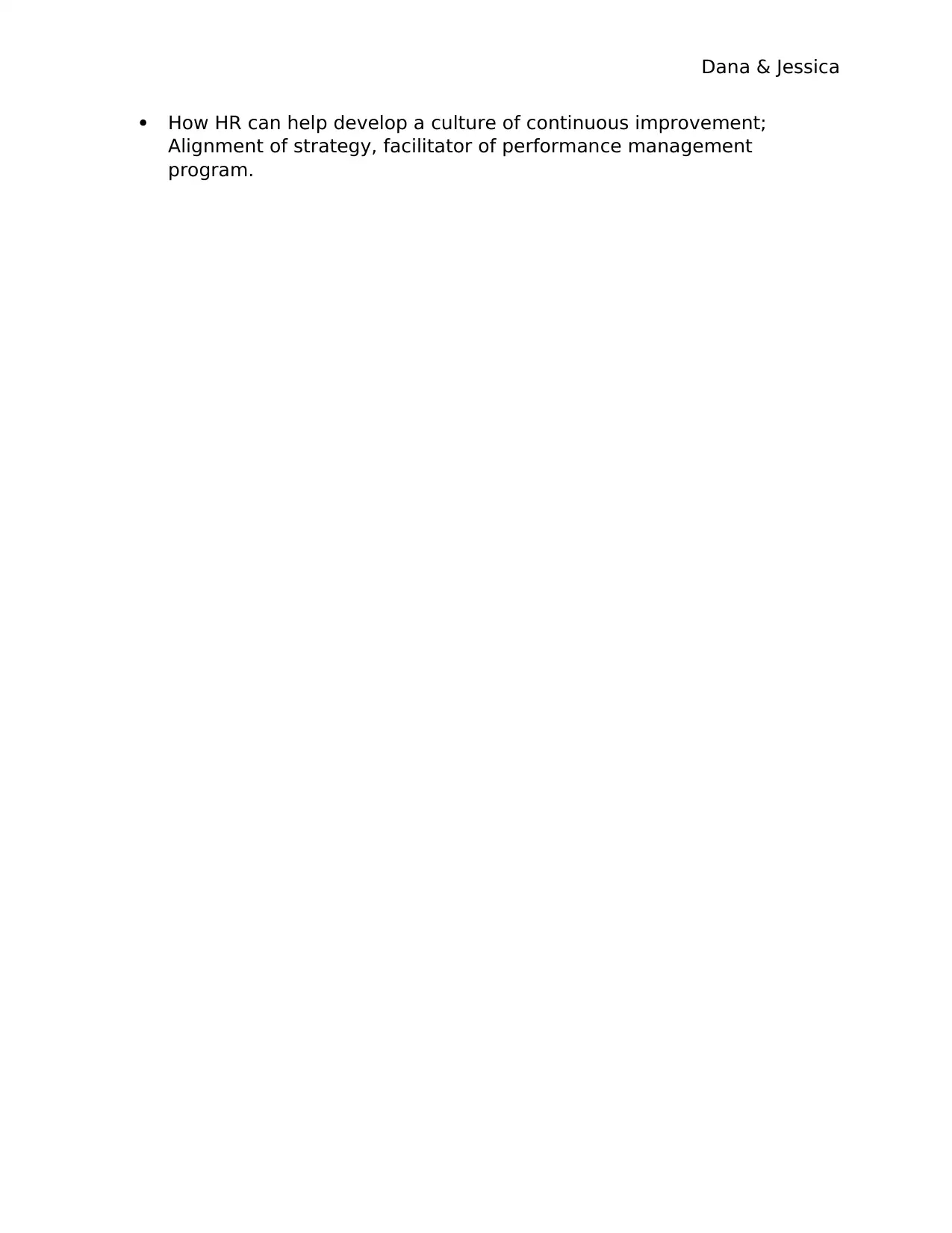
Dana & Jessica
How HR can help develop a culture of continuous improvement;
Alignment of strategy, facilitator of performance management
program.
How HR can help develop a culture of continuous improvement;
Alignment of strategy, facilitator of performance management
program.
1 out of 7
Related Documents
Your All-in-One AI-Powered Toolkit for Academic Success.
+13062052269
info@desklib.com
Available 24*7 on WhatsApp / Email
![[object Object]](/_next/static/media/star-bottom.7253800d.svg)
Unlock your academic potential
© 2024 | Zucol Services PVT LTD | All rights reserved.





